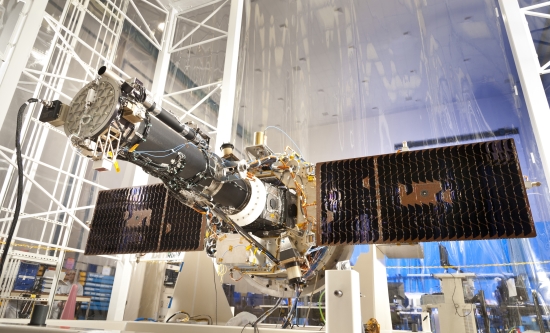September 3, 2013 – Acton, Massachusetts - Princeton Instruments is pleased to announce that the Acton Optics & Coatings product line has provided a number of critical optical coatings in use in the recently launched NASA IRIS Explorer Mission via contracts with Lockheed Martin and major partners Smithsonian Astrophysical Observatory and Montana State University. These far ultraviolet and ultraviolet reflective optical coatings are an integral part of both the IRIS telescope and the IRIS spectrograph units of the mission instrumentation. IRIS was launched into orbit on June 28, 2013 and is in a sun-synchronous polar orbit that will allow it to make almost continuous solar observations during its two-year mission.
The wavelength bands of interest for this mission are the FUV (133.2nm to 140.6nm) and NUV (278.5nm to 283.5nm). The mirror coatings provided for the IRIS telescope exhibit high reflectivity in the FUV band while maintaining a fixed reflectivity in the NUV band to limit crosstalk into the FUV band and low reflectivity in the visible and infrared. A variety of coatings for components within the IRIS spectrograph were provided including camera mirrors, fold mirrors, reimaging mirrors, and collimating mirrors, in additional to a FUV bandpass filter. The coatings for the spectrograph and slit jaw imager provide maximum on-band and minimum off-band reflectivity at the selectable emission lines in these two bands to allow observation of many wavelengths at once.
"The quality of images and spectra we are receiving from IRIS is amazing. This is just what we were hoping for," said Dr. Alan Title, IRIS principal investigator and physicist at the Lockheed Martin Advanced Technology Center (ATC) Solar and Astrophysics Laboratory in Palo Alto, Calif. "There is much work ahead to understand what we’re seeing, but the quality of the data will enable us to do that."
"IRIS was an excellent opportunity for the Acton Optics & Coatings team to demonstrate our expertise in UV coatings design and manufacturing," said Matt Lyons, Business Manager of the Acton Optics & Coatings product line. "We were provided mission spectral goals and, as we do with many of our customers, we engineered thin film coatings that offer unique reflectivity, transmission and blocking properties that advance our customers scientific goals. Very interesting science is being conducted in the UV and we are pleased our products can help researchers make advances in this important spectral region."
Acton Optics & Coatings has a long history of providing long-lifetime, high-performance optics and coatings for numerous astronomy projects including SDO (AIA), Lyra, PICARD/SODISM, Cassini, Hubble, SOHO (UVCS), TRACE and WISP.
About the IRIS Explorer Mission
(from NASA website):
IRIS is a NASA Explorer Mission to observe how solar material moves, gathers energy and heats up as it travels through a little-understood region in the sun's lower atmosphere. This interface region between the sun's photosphere and corona powers its dynamic million-degree atmosphere and drives the solar wind. The interface region also is where most of the sun's ultraviolet emission is generated. These emissions impact the near-Earth space environment and Earth's climate.
Designed to research the interface region in more detail than has ever been done before, IRIS's instrument is a combination of an ultraviolet telescope and a spectrograph. The telescope provides high-resolution images, capturing data on about 1 percent of the sun at a time. The images can resolve very fine features, as small as 150 miles across.
About Princeton Instruments and Acton Optics & Coatings
Princeton Instruments, a subsidiary of Roper Industries (ROP:NYSE), designs and manufactures high-performance CCD, ICCD, and EMCCD cameras; spectrographs; and optics-based solutions for the scientific research, industrial imaging, and OEM communities. We take pride in partnering with our customers to solve their most challenging problems in unique, innovative ways. For more information on Princeton Instruments products, please visit www.princetoninstruments.com.
Princeton Instruments’ Acton Optics & Coatings product line is a specialist in thin film coatings for 120-1100nm wavelength range. Acton has unique expertise in optical monitoring, coating materials, optical metrology and quality procedures all focused on manufacturing state of the art UV optics & coatings. Acton Optics & Coatings is ISO 9001:2000 certified and maintains the commitment to provide superior optical products in markets including laser, semiconductor, medical, aerospace, research, imaging and more.













